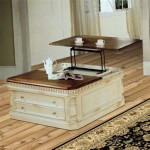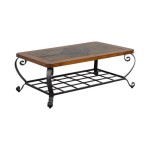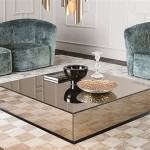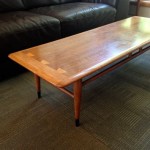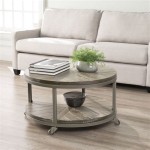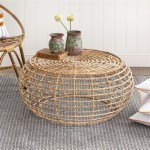What Is The Average Size Of A Coffee Table?
Determining the average size of a coffee table is not as straightforward as pinpointing a single, universally accepted measurement. The ideal size is highly dependent on several factors, including the size of the living room, the configuration of the seating arrangement, and the intended functionality of the table. A coffee table that is perfectly proportioned for one space may appear either dwarfed or overwhelming in another. Therefore, rather than fixating on a single "average," it is more useful to understand the common size ranges and the guidelines that inform appropriate selection.
The term 'average' can be misleading in this context. It is more accurate to consider the most frequently encountered dimensions and the principles of scale and proportion that interior designers and furniture manufacturers typically adhere to. These principles ensure that the coffee table complements the surrounding furniture and contributes to a harmonious and functional living space.
One must consider length, width, and height when assessing the size of a coffee table. Each dimension plays a crucial role in determining its suitability for a particular room. Understanding the typical ranges for each of these dimensions will allow for a more informed decision when selecting a coffee table.
Key Point 1: Standard Coffee Table Dimensions
While an absolute "average" figure is difficult to define, a range of common sizes exists. The most frequently encountered length for a rectangular coffee table falls between 48 and 60 inches. This provides ample surface area for practical use while maintaining a balanced aesthetic in most living rooms. Widths typically range from 24 to 36 inches, offering sufficient space for items like books, remote controls, and decorative objects. The height of a coffee table is perhaps the most crucial dimension, often ranging from 16 to 18 inches. This height is generally considered optimal for most standard sofas, allowing for easy access to items placed on the table without requiring excessive reaching or bending.
It is important to note that these figures represent the dimensions of rectangular coffee tables, which are the most common style. Other shapes, such as square or round tables, will have different standard measurements. A square coffee table, for instance, commonly ranges from 36 to 48 inches on each side. Round coffee tables typically range from 30 to 48 inches in diameter.
Deviations from these standard dimensions are not uncommon and may be necessary to accommodate specific spatial requirements or design preferences. Smaller living rooms may benefit from coffee tables that fall below the lower end of the length and width ranges, while larger spaces may require larger tables to maintain visual balance.
The height of the coffee table is particularly important in relation to the height of the sofa. Ideally, the coffee table should be approximately the same height as the sofa's seat cushions, or slightly lower. This ensures that the table is easily accessible and provides a comfortable surface for placing items. A coffee table that is significantly taller than the sofa can feel awkward and impede conversation.
Furthermore, the style of the sofa can influence the appropriate height of the coffee table. Low-slung sofas, for example, may necessitate a lower coffee table to maintain proportional harmony. Conversely, sofas with higher seats may require a slightly taller coffee table.
The consideration of these dimensions ensures that the coffee table does not only fit in the space but also enhances the functionality and aesthetic appeal of the room. This is more important than adhering to a rigid definition of average.
Key Point 2: The Importance of Room Size and Layout
The dimensions of the living room are a primary determinant of the appropriate coffee table size. A large room can accommodate a larger coffee table without feeling cramped, while a small room requires a smaller table to avoid overwhelming the space. The goal is to achieve a sense of proportion and balance, ensuring that the coffee table contributes to the overall harmony of the room.
In smaller living rooms, opting for a coffee table that is too large can create a feeling of congestion and impede movement. A smaller, more streamlined table, or even a pair of smaller side tables, may be a more effective solution. These options allow for sufficient surface space without sacrificing valuable floor space. Conversely, in larger living rooms, a small coffee table may appear insignificant and fail to provide adequate functionality. A larger table, or even two smaller tables placed side-by-side, may be a more appropriate choice.
The layout of the room also plays a crucial role in determining the ideal coffee table size. The distance between the sofa and the television, the placement of other furniture pieces, and the overall flow of traffic within the room must all be considered. A coffee table that is too large can obstruct pathways and create a sense of confinement, while a table that is too small may fail to adequately serve the seating area.
A good rule of thumb is to leave approximately 18 inches of space between the coffee table and the sofa. This provides ample room for people to move comfortably around the table without bumping into it. The distance between the coffee table and other furniture pieces, such as chairs or side tables, should also be considered to ensure a smooth and functional layout.
For irregularly shaped rooms, the coffee table can actually help to define the seating area. An oddly shaped room might be broken into separate spaces, and the coffee table helps to define that space.
Ultimately, the best approach is to measure the available space and carefully consider the layout of the room before selecting a coffee table. This will help ensure that the table is appropriately sized and contributes to a comfortable and functional living space.
Key Point 3: Functionality and Intended Use
The intended use of the coffee table is another crucial factor to consider when determining the appropriate size. A coffee table that is primarily intended for decorative purposes may be smaller and more aesthetically focused, while a table that is intended for everyday use, such as placing drinks or snacks, may need to be larger and more practical.
If the coffee table is intended to serve as a central gathering point for entertaining guests, a larger surface area may be necessary to accommodate drinks, appetizers, and other items. In this case, a rectangular or oval-shaped table may be a more suitable choice than a smaller, round table. Alternatively, if the coffee table is primarily intended for personal use, such as reading or working on a laptop, a smaller table may suffice.
The storage needs of the living room can also influence the appropriate coffee table size. Coffee tables with built-in storage, such as drawers or shelves, can be a valuable addition to small living rooms, providing a convenient place to store books, magazines, and other items. These tables tend to be larger than standard coffee tables, but the added storage can compensate for the increased size.
Consideration should also be given to the types of activities that will take place around the coffee table. If children will be using the table, a larger, more durable table may be necessary to withstand wear and tear. Additionally, the shape of the table should be carefully considered to minimize the risk of injury. Round or oval tables are generally safer choices than tables with sharp corners.
For instance, a family with young children might prioritize a coffee table with rounded edges and a durable surface that is easy to clean. This might entail sacrificing some aesthetic appeal for greater practicality and safety.
Ultimately, selecting the appropriate coffee table size requires a careful consideration of the intended use and the specific needs of the living room. By prioritizing functionality, it is possible to choose a coffee table that is both practical and aesthetically pleasing.

How To Buy A Coffee Table Living Spaces

The Ultimate Coffee Table Size Guide Apt2b

How To Buy A Coffee Table Living Spaces

Coffee Table Dimensions Size Guide Measurements Height

How To Choose The Right Coffee Table Dimensions Doğtaş

Star Furniture

How To Choose The Right Coffee Table Dimensions Doğtaş

How To Choose The Right Coffee Table Dimensions Doğtaş

How To Choose The Right Coffee Table Dimensions Doğtaş

How To Buy A Coffee Table Living Spaces
Related Posts


